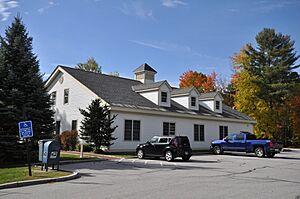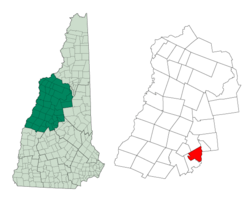Bridgewater, New Hampshire facts for kids
Quick facts for kids
Bridgewater, New Hampshire
|
|
|---|---|
|
Town
|
|

Town hall
|
|

Location in Grafton County, New Hampshire
|
|
| Country | United States |
| State | New Hampshire |
| County | Grafton |
| Incorporated | 1788 |
| Area | |
| • Total | 21.7 sq mi (56.2 km2) |
| • Land | 21.5 sq mi (55.7 km2) |
| • Water | 0.2 sq mi (0.5 km2) 0.97% |
| Elevation | 640 ft (195 m) |
| Population
(2020)
|
|
| • Total | 1,160 |
| • Density | 54/sq mi (20.8/km2) |
| Time zone | UTC-5 (Eastern) |
| • Summer (DST) | UTC-4 (Eastern) |
| ZIP Codes | |
| Area code(s) | 603 |
| FIPS code | 33-07540 |
| GNIS feature ID | 0873551 |
Bridgewater is a small town in Grafton County, New Hampshire, in the United States. In 2020, about 1,160 people lived there.
Contents
History of Bridgewater
How Bridgewater Began
The land that is now Bridgewater was once part of a larger area called "New Chester." Over time, this big area was split into several towns. These towns included Bridgewater, Bristol, Hill, Danbury, and Wilmot.
The town was named Bridgewater because many of the first people who settled there came from a town called Bridgewater, Massachusetts.
Early Settlers and Growth
Bridgewater originally included the areas that are now Bridgewater, Hill, and Bristol. The very first settler arrived in 1776. His name was Thomas Crawford.
The town officially became a town on February 12, 1788. This is called its "incorporation" date. It means the town was given its own legal government.
Later, in 1874, a train station in Bridgewater was used by the Montreal railroad. This helped connect the town to other places.
Geography of Bridgewater
Land and Water
Bridgewater covers a total area of about 56.2 square kilometers (about 21.7 square miles). Most of this area is land, which is about 55.7 square kilometers (21.5 square miles).
A small part of the town, about 0.5 square kilometers (0.2 square miles), is water. This means water makes up less than 1% of the town's total area.
Natural Features
The highest point in Bridgewater is a place called Peaked Hill. It stands about 581 meters (1,905 feet) above sea level.
Bridgewater is also part of the Merrimack River watershed. This means that all the rain and snow that falls in Bridgewater eventually flows into the Merrimack River.
The western edge of the town follows the eastern shore of Newfound Lake. This is a beautiful lake that adds to the town's natural scenery.
Population Information
| Historical population | |||
|---|---|---|---|
| Census | Pop. | %± | |
| 1790 | 281 | — | |
| 1800 | 664 | 136.3% | |
| 1810 | 1,104 | 66.3% | |
| 1820 | 727 | −34.1% | |
| 1830 | 783 | 7.7% | |
| 1840 | 747 | −4.6% | |
| 1850 | 667 | −10.7% | |
| 1860 | 560 | −16.0% | |
| 1870 | 453 | −19.1% | |
| 1880 | 384 | −15.2% | |
| 1890 | 332 | −13.5% | |
| 1900 | 244 | −26.5% | |
| 1910 | 187 | −23.4% | |
| 1920 | 199 | 6.4% | |
| 1930 | 151 | −24.1% | |
| 1940 | 226 | 49.7% | |
| 1950 | 222 | −1.8% | |
| 1960 | 293 | 32.0% | |
| 1970 | 398 | 35.8% | |
| 1980 | 606 | 52.3% | |
| 1990 | 796 | 31.4% | |
| 2000 | 974 | 22.4% | |
| 2010 | 1,083 | 11.2% | |
| 2020 | 1,160 | 7.1% | |
| U.S. Decennial Census | |||
How Many People Live Here?
In 2000, there were 974 people living in Bridgewater. These people lived in 414 different homes. About 289 of these homes were families.
The population density was about 45.8 people for every square mile. This tells us how many people live in a certain area.
Who Lives in Bridgewater?
Most people in Bridgewater are White. A very small number of people are Native American or Asian.
About 24.9% of homes had children under 18 living there. Many homes, about 61.6%, were married couples living together.
The average age of people in Bridgewater was 45 years old. About 19.7% of the population was under 18 years old.
Education in Bridgewater
Local Schools
Bridgewater is part of the Newfound Area School District. This district helps manage the schools in the area.
There is a school right in Bridgewater called Bridgewater-Hebron Village School.
For older students, the district has two secondary schools. These are Newfound Memorial Middle School and Newfound Regional High School. Both of these schools are located in the nearby town of Bristol.
See also
 In Spanish: Bridgewater (Nuevo Hampshire) para niños
In Spanish: Bridgewater (Nuevo Hampshire) para niños

